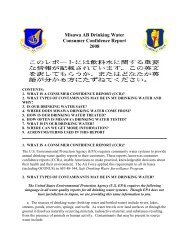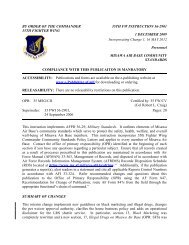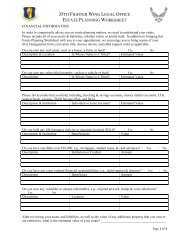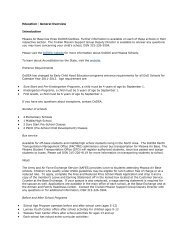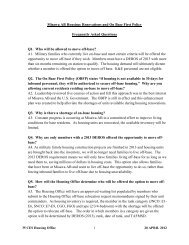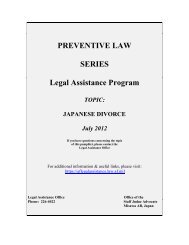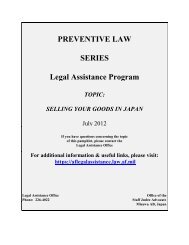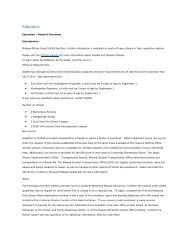Joint Tactical Ground Station (JTAG) - Misawa Air Base
Joint Tactical Ground Station (JTAG) - Misawa Air Base
Joint Tactical Ground Station (JTAG) - Misawa Air Base
Create successful ePaper yourself
Turn your PDF publications into a flip-book with our unique Google optimized e-Paper software.
1. DINING OUT<br />
In department store and some other restaurants, you must buy tickets for your food before you sit down.<br />
Wax models of the foods are usual located at the entrance. After making your selection, tell it to the<br />
cashier. You will pay at this time and the cashier will give you tickets. If you can’t read the name of<br />
your selection, ask the cashier to follow you to the display case and point to what you want. The waiter<br />
will tear your tickets in half and bring your items when they are ready<br />
Some useful phrases:<br />
Please give me a fork. ............................. (Fooku o kudasai.)<br />
Please give me a spoon. .......................... (Supuun o kudasai.)<br />
Please give me (a glass of) water. .......... (Omizu o kudasai.)<br />
Coffee ..................................................... (Koohii)<br />
Coca cola ................................................ (Kohka kora)<br />
Black tea ................................................. (Koocha)<br />
Green tea................................................. (Ocha)<br />
Note- Japanese (green) tea is usually available free for the asking in many restaurants. Other<br />
beverages can be quite expensive. Ocha is drunk unsweetened.<br />
2. WHAT’S ON THE MENU?<br />
We’ve listed some foods which you might like to try when you first arrive. The name of each in Roman<br />
letters and Japanese characters to help you recognize it on a menu or food display. Enjoy!<br />
Gohan (rice, ご飯, ごはん) – Plain, steamed rice<br />
Chaanan (fried rice, 炒飯, チャーハン) – rice fried with onions, vegetables and sometimes meat<br />
Karee-raisu (curry rice, カレーライス) – Steamed rice with a curry sauce over it, containing various<br />
meats or seafood, and usually vegetables.<br />
Tempura (天ぷら, てんぷら) – Shrimp and vegetables coated with a batter and deep-fried. Served with a<br />
dipping sauce.<br />
Tendon (天丼) – A bowl of rice with deep-fried shrimp and/or fish. A thin sauce is poured over also that<br />
the shrimp are not as crispy as in Tempura. This usually comes with a bowl of broth soup and a small<br />
dish of pickled vegetables.<br />
Yakisoba (Fried noodles, 焼きそば, やきそば) - Soft Chinese noodles fried with onions, cabbage,<br />
carrots and meat of seafood, flavored with soy sauce or a lightly sweeter sauce.<br />
Sukiyaki (すき焼, すきやき) – Cooked at your table, this dish can fairly expensive. Thin slices of beef<br />
and vegetables are cooked in a mixture of soy sauce, sake and sugar. A raw egg is provided with each<br />
dinner. Mix it up a bit and dip your meat land vegetables into it before eating them.<br />
Gyoza (餃子, ぎょうざ) – Crescent-shaped Chinese pastries filled with ground pork, cabbage and green<br />
onions. Many people prefer them fried, but they can be boiled or steamed. Dip into a mixture of sesame<br />
seed oil, vinegar, and hot pepper.<br />
47




